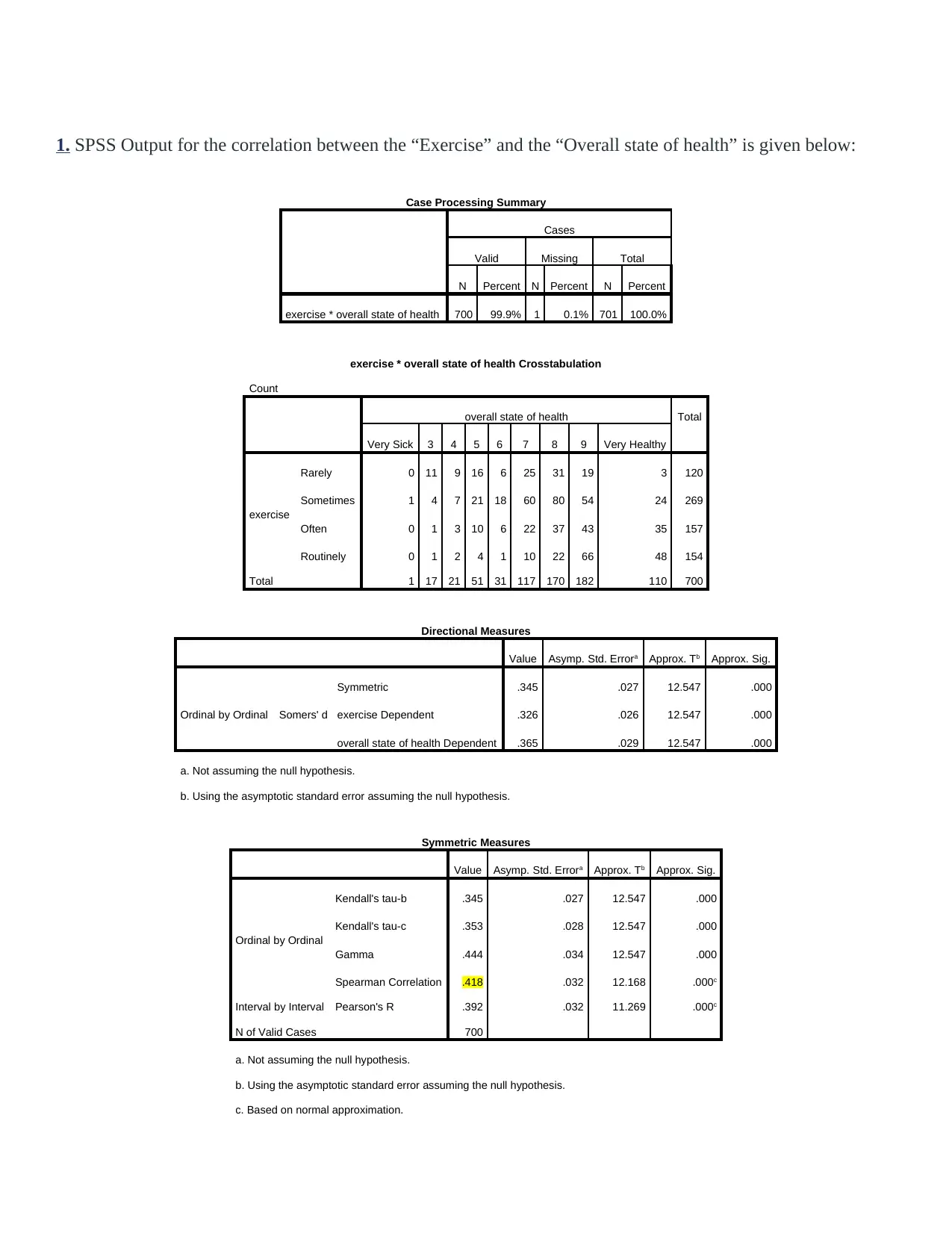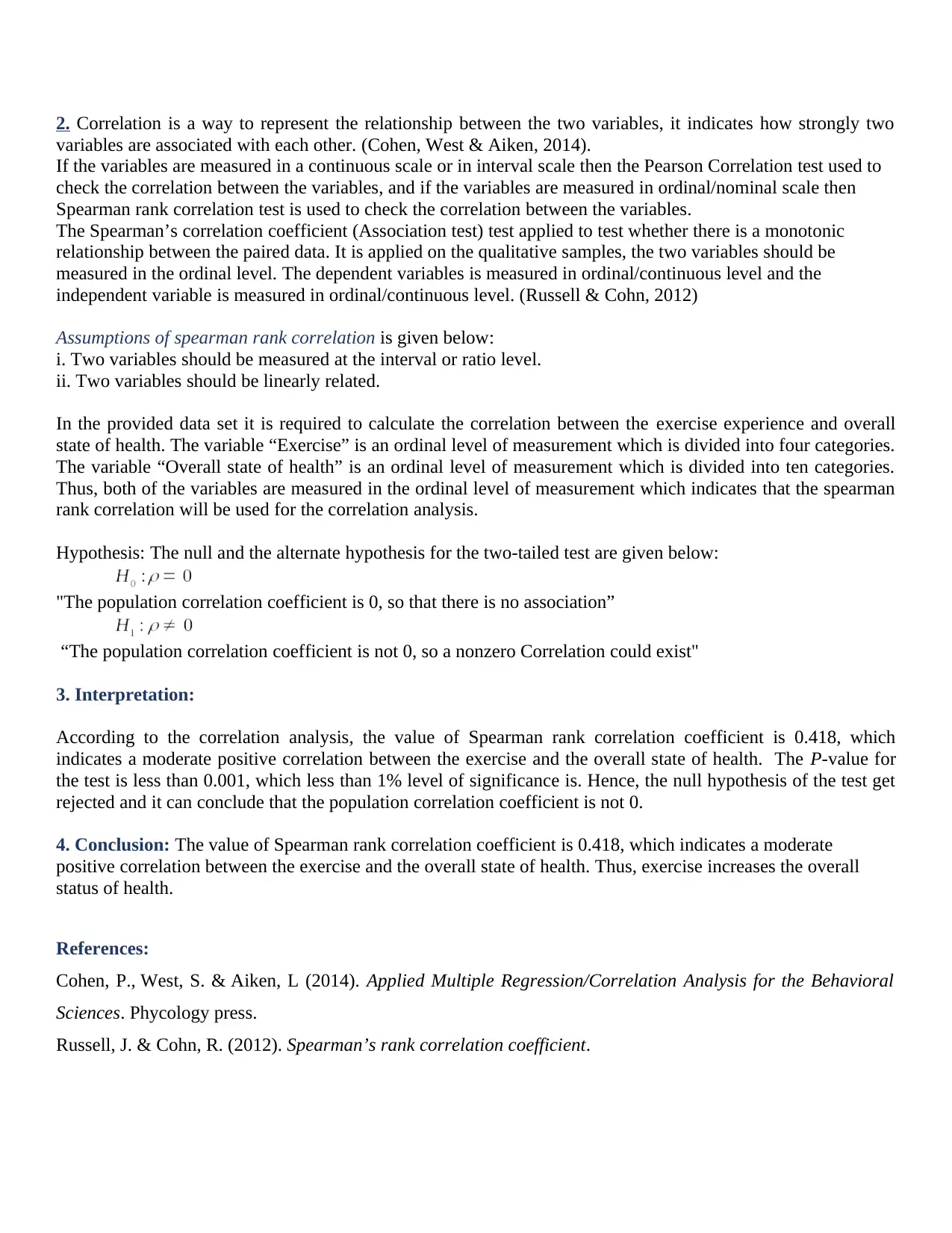Correlation Analysis between Exercise and Overall State of Health
VerifiedAdded on 2021/04/17
|2
|770
|86
AI Summary
The assignment requires analyzing the relationship between exercise experience and overall state of health using Spearman's rank correlation coefficient. The results indicate a moderate positive correlation, suggesting that exercise increases overall status of health.
Contribute Materials
Your contribution can guide someone’s learning journey. Share your
documents today.

1. SPSS Output for the correlation between the “Exercise” and the “Overall state of health” is given below:
Case Processing Summary
Cases
Valid Missing Total
N Percent N Percent N Percent
exercise * overall state of health 700 99.9% 1 0.1% 701 100.0%
exercise * overall state of health Crosstabulation
Count
overall state of health Total
Very Sick 3 4 5 6 7 8 9 Very Healthy
exercise
Rarely 0 11 9 16 6 25 31 19 3 120
Sometimes 1 4 7 21 18 60 80 54 24 269
Often 0 1 3 10 6 22 37 43 35 157
Routinely 0 1 2 4 1 10 22 66 48 154
Total 1 17 21 51 31 117 170 182 110 700
Directional Measures
Value Asymp. Std. Errora Approx. Tb Approx. Sig.
Ordinal by Ordinal Somers' d
Symmetric .345 .027 12.547 .000
exercise Dependent .326 .026 12.547 .000
overall state of health Dependent .365 .029 12.547 .000
a. Not assuming the null hypothesis.
b. Using the asymptotic standard error assuming the null hypothesis.
Symmetric Measures
Value Asymp. Std. Errora Approx. Tb Approx. Sig.
Ordinal by Ordinal
Kendall's tau-b .345 .027 12.547 .000
Kendall's tau-c .353 .028 12.547 .000
Gamma .444 .034 12.547 .000
Spearman Correlation .418 .032 12.168 .000c
Interval by Interval Pearson's R .392 .032 11.269 .000c
N of Valid Cases 700
a. Not assuming the null hypothesis.
b. Using the asymptotic standard error assuming the null hypothesis.
c. Based on normal approximation.
Case Processing Summary
Cases
Valid Missing Total
N Percent N Percent N Percent
exercise * overall state of health 700 99.9% 1 0.1% 701 100.0%
exercise * overall state of health Crosstabulation
Count
overall state of health Total
Very Sick 3 4 5 6 7 8 9 Very Healthy
exercise
Rarely 0 11 9 16 6 25 31 19 3 120
Sometimes 1 4 7 21 18 60 80 54 24 269
Often 0 1 3 10 6 22 37 43 35 157
Routinely 0 1 2 4 1 10 22 66 48 154
Total 1 17 21 51 31 117 170 182 110 700
Directional Measures
Value Asymp. Std. Errora Approx. Tb Approx. Sig.
Ordinal by Ordinal Somers' d
Symmetric .345 .027 12.547 .000
exercise Dependent .326 .026 12.547 .000
overall state of health Dependent .365 .029 12.547 .000
a. Not assuming the null hypothesis.
b. Using the asymptotic standard error assuming the null hypothesis.
Symmetric Measures
Value Asymp. Std. Errora Approx. Tb Approx. Sig.
Ordinal by Ordinal
Kendall's tau-b .345 .027 12.547 .000
Kendall's tau-c .353 .028 12.547 .000
Gamma .444 .034 12.547 .000
Spearman Correlation .418 .032 12.168 .000c
Interval by Interval Pearson's R .392 .032 11.269 .000c
N of Valid Cases 700
a. Not assuming the null hypothesis.
b. Using the asymptotic standard error assuming the null hypothesis.
c. Based on normal approximation.
Secure Best Marks with AI Grader
Need help grading? Try our AI Grader for instant feedback on your assignments.

2. Correlation is a way to represent the relationship between the two variables, it indicates how strongly two
variables are associated with each other. (Cohen, West & Aiken, 2014).
If the variables are measured in a continuous scale or in interval scale then the Pearson Correlation test used to
check the correlation between the variables, and if the variables are measured in ordinal/nominal scale then
Spearman rank correlation test is used to check the correlation between the variables.
The Spearman’s correlation coefficient (Association test) test applied to test whether there is a monotonic
relationship between the paired data. It is applied on the qualitative samples, the two variables should be
measured in the ordinal level. The dependent variables is measured in ordinal/continuous level and the
independent variable is measured in ordinal/continuous level. (Russell & Cohn, 2012)
Assumptions of spearman rank correlation is given below:
i. Two variables should be measured at the interval or ratio level.
ii. Two variables should be linearly related.
In the provided data set it is required to calculate the correlation between the exercise experience and overall
state of health. The variable “Exercise” is an ordinal level of measurement which is divided into four categories.
The variable “Overall state of health” is an ordinal level of measurement which is divided into ten categories.
Thus, both of the variables are measured in the ordinal level of measurement which indicates that the spearman
rank correlation will be used for the correlation analysis.
Hypothesis: The null and the alternate hypothesis for the two-tailed test are given below:
"The population correlation coefficient is 0, so that there is no association”
“The population correlation coefficient is not 0, so a nonzero Correlation could exist"
3. Interpretation:
According to the correlation analysis, the value of Spearman rank correlation coefficient is 0.418, which
indicates a moderate positive correlation between the exercise and the overall state of health. The P-value for
the test is less than 0.001, which less than 1% level of significance is. Hence, the null hypothesis of the test get
rejected and it can conclude that the population correlation coefficient is not 0.
4. Conclusion: The value of Spearman rank correlation coefficient is 0.418, which indicates a moderate
positive correlation between the exercise and the overall state of health. Thus, exercise increases the overall
status of health.
References:
Cohen, P., West, S. & Aiken, L (2014). Applied Multiple Regression/Correlation Analysis for the Behavioral
Sciences. Phycology press.
Russell, J. & Cohn, R. (2012). Spearman’s rank correlation coefficient.
variables are associated with each other. (Cohen, West & Aiken, 2014).
If the variables are measured in a continuous scale or in interval scale then the Pearson Correlation test used to
check the correlation between the variables, and if the variables are measured in ordinal/nominal scale then
Spearman rank correlation test is used to check the correlation between the variables.
The Spearman’s correlation coefficient (Association test) test applied to test whether there is a monotonic
relationship between the paired data. It is applied on the qualitative samples, the two variables should be
measured in the ordinal level. The dependent variables is measured in ordinal/continuous level and the
independent variable is measured in ordinal/continuous level. (Russell & Cohn, 2012)
Assumptions of spearman rank correlation is given below:
i. Two variables should be measured at the interval or ratio level.
ii. Two variables should be linearly related.
In the provided data set it is required to calculate the correlation between the exercise experience and overall
state of health. The variable “Exercise” is an ordinal level of measurement which is divided into four categories.
The variable “Overall state of health” is an ordinal level of measurement which is divided into ten categories.
Thus, both of the variables are measured in the ordinal level of measurement which indicates that the spearman
rank correlation will be used for the correlation analysis.
Hypothesis: The null and the alternate hypothesis for the two-tailed test are given below:
"The population correlation coefficient is 0, so that there is no association”
“The population correlation coefficient is not 0, so a nonzero Correlation could exist"
3. Interpretation:
According to the correlation analysis, the value of Spearman rank correlation coefficient is 0.418, which
indicates a moderate positive correlation between the exercise and the overall state of health. The P-value for
the test is less than 0.001, which less than 1% level of significance is. Hence, the null hypothesis of the test get
rejected and it can conclude that the population correlation coefficient is not 0.
4. Conclusion: The value of Spearman rank correlation coefficient is 0.418, which indicates a moderate
positive correlation between the exercise and the overall state of health. Thus, exercise increases the overall
status of health.
References:
Cohen, P., West, S. & Aiken, L (2014). Applied Multiple Regression/Correlation Analysis for the Behavioral
Sciences. Phycology press.
Russell, J. & Cohn, R. (2012). Spearman’s rank correlation coefficient.
1 out of 2
Your All-in-One AI-Powered Toolkit for Academic Success.
+13062052269
info@desklib.com
Available 24*7 on WhatsApp / Email
![[object Object]](/_next/static/media/star-bottom.7253800d.svg)
Unlock your academic potential
© 2024 | Zucol Services PVT LTD | All rights reserved.

